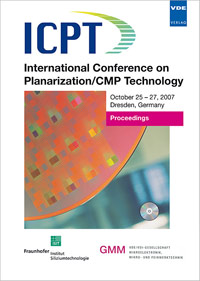Material & Design Considerations for Zero Defect CMP Pads7
Conference: ICPT 2007 - International Conference on Planarization / CMP Technology
10/25/2007 - 10/27/2007 at Dresden, Germany
Proceedings: ICPT 2007
Pages: 7Language: englishTyp: PDF
Personal VDE Members are entitled to a 10% discount on this title
Authors:
Carpio, R.; Tolic, F. (ATDF, 2706 Montopolis Dr., Austin, TX, 78741.)
Hymes, S.; Bajaj, R. (SemiQuest Inc., 2363 Bering, Dr., San Jose, CA, 95131)
Abstract:
Copper CMP process defectivity shows high correlation to process yield. For a given slurry, mechanical and tribological properties of the pad impact planarization and defectivity performance of the process. Typically, hard pads show higher defectivity and slurry distribution at the wafer-pad interface influences defectivity. Additionally conditioning process generates organic debris comprised of pad material and inorganic constituents such as polish by-products and slurry particles and is a source of significant defectivity. Conventional pad architecture must meet material requirements as well as provide adequate channels for slurry distribution and by-product removal. Significant effort has been made to overcome limitations of conventional pads through investigation of the role of mechanical and tribological properties of polish surface. Similarly, efforts have been made to develop an understanding of the role of conditioning and grooving with respect to surface asperities and slurry distribution. While significant improvements have been made, key performance limitations of conventional planar pad architecture remain.


